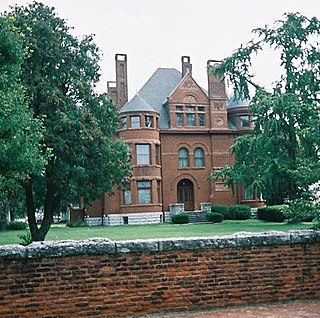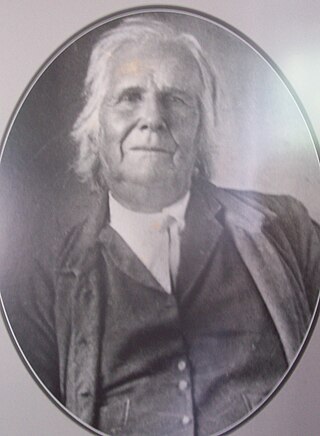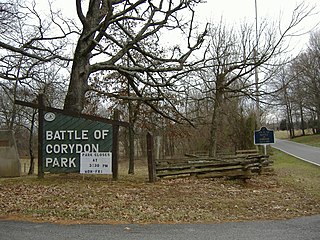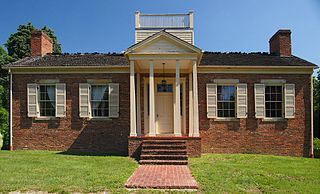
Harrison County is located in the far southern part of the U.S. state of Indiana along the Ohio River. The county was officially established in 1808. Its population was 39,654 as of the 2020 United States Census. Its county seat is Corydon, the former capital of Indiana.

Corydon is a town in Harrison Township, Harrison County, Indiana. Located north of the Ohio River in the extreme southern part of the U.S. state of Indiana, it is the seat of government for Harrison County. Corydon was founded in 1808 and served as the capital of the Indiana Territory from 1813 to 1816. It was the site of Indiana's first constitutional convention, which was held June 10–29, 1816. Forty-three delegates convened to consider statehood for Indiana and drafted its first state constitution. Under Article XI, Section 11, of the Indiana 1816 constitution, Corydon was designated as the capital of the state, which it remained until 1825, when the seat of state government was moved to Indianapolis. In 1863, during the American Civil War, Corydon was the site of the Battle of Corydon, the only official pitched battle waged in Indiana during the war. More recently, the town's numerous historic sites have helped it become a tourist destination. A portion of its downtown area is listed in the National Register of Historic Places as the Corydon Historic District. As of the 2010 census, Corydon had a population of 3,122.

Grouseland, the William Henry Harrison Mansion and Museum, is a National Historic Landmark important for its Federal-style architecture and role in American history. The two-story, red brick home was built between 1802 and 1804 in Vincennes, Indiana, for William Henry Harrison (1773–1841) during his tenure from 1801 to 1812 as the first governor of the Indiana Territory. The residence was completed in 1804, and Harrison reportedly named it Grouseland due to the abundance of grouse in the area.

The Battle of Corydon was a minor engagement that took place July 9, 1863, just south of Corydon, which had been the original capital of Indiana until 1825, and was the county seat of Harrison County. The attack occurred during Morgan's Raid in the American Civil War as a force of 2,500 cavalry invaded the North in support of the Tullahoma Campaign. It was the only pitched battle of the Civil War that occurred in Indiana, and no battle has occurred within Indiana since.

The Howard Steamboat Museum, or the Howard National Steamboat Museum, is located in Jeffersonville, Indiana, across from Louisville, Kentucky. House in the Howard Family mansion, it features items related to steamboat history and specifically, the Howard Shipyards of Jeffersonville, IN. The building is listed on the National Register of Historic Places.

Culbertson Mansion State Historic Site is located in New Albany, Indiana by the Ohio River. It was the home of William Culbertson, who was once the richest man in Indiana. Built in 1867 at a cost of $120,000, this Second Empire-style mansion has 25-rooms within 20,000 square feet (1,900 m2), and was completed in November 1869. It was designed by James T. Banes, a local architect. Features within the three-story edifice include hand-painted ceilings and walls, frescoed ceilings, carved rosewood-grained staircase, marble fireplaces, wallpaper of fabric-quality, and crystal chandeliers. The original tin roof was imported from Scotland. The displays within the mansion feature the Culbertson family and the restoration of the building. The rooms on the tour are the formal parlors, dining rooms, bedrooms, kitchen, and laundry room.

The Corydon Historic District is a national historic district located in Corydon, Indiana, United States. The town of Corydon is also known as Indiana's First State Capital and as Historic Corydon. The district was added to the National Register of Historic Places in 1973, but the listing was amended in 1988 to expand the district's geographical boundaries and include additional sites. The district includes numerous historical structures, most notably the Old Capitol, the Old Treasury Building, Governor Hendricks' Headquarters, the Constitution Elm Memorial, the Posey House, the Kintner-McGrain House, and The Kintner House Inn, as well as other residential and commercial sites.

The Kintner–Withers House, also known as Cedar Farm, is on the National Register of Historic Places, south of Laconia, Indiana, along the Ohio River in Boone Township, Harrison County, Indiana. Jacob Kintner, aided by his wife Elizabeth, built the structure in 1837. It is one of only 2 "antebellum plantation-style" complexes known to remain in Indiana, comprised originally on 600 acres (240 ha) of land. It is believed that Kintner was inspired to build this after sailing on the Mississippi River to New Orleans.

The Kintner House Hotel is a historic bed & breakfast, in the Corydon Historic District in Corydon, Indiana. The present building was built in 1873, and is a 2+1⁄2-story, Italianate style brick building. The original Kintner House, two blocks away, was where John Hunt Morgan learned that Robert E. Lee lost at the Battle of Gettysburg. The Kintner House remained a hotel until 1920 and was used as offices until 1986. It was extensively restored and opened as a bed and breakfast in 1987.

Boone Township is one of 12 townships in Harrison County, Indiana, United States. As of the 2010 census, its population was 1,391 and it contained 628 housing units.

Dennis Pennington was a farmer and a stonemason who became known for his many years in public office as an early legislator in the Indiana Territory and in Indiana's General Assembly as a representative of Harrison County, Indiana. Pennington, a member of the Whig Party, became the first speaker of the Indiana territorial legislature's lower house in 1810, served as the territory's census enumerator in 1815, and represented Harrison County as one of its five delegates to the constitutional convention of 1816. Pennington was the first speaker of the Indiana Senate, and served in the state legislature for eighteen years, which included five years in the Indiana House of Representatives and thirteen years in the Indiana Senate. His major political contributions relate to his strong opposition to slavery. Pennington ran unsuccessfully for Indiana's Lieutenant Governor in 1825. In addition to his service in the state legislature, Penning was a Harrison County sheriff and a justice of the peace, a trustee of Indiana University, and a member of the Grand Lodge of Indiana. He also supervised construction of the limestone courthouse that served as Indiana's first state capitol building in Corydon, Indiana. The historic Old Capitol, the seat of state government from 1816 to 1825, is one of his most enduring legacies. Fondly remembered as "Old Uncle Dennis" or "Father Pennington," he was known for his common sense and strong character and became one of Harrison County's most influential citizens.
Davis Floyd was an Indiana Jeffersonian Republican politician who was convicted of aiding American Vice President Aaron Burr in the Burr conspiracy. Floyd was not convicted of treason however and returned to public life after several years working to redeem his reputation. He lost his wealth in the Panic of 1819 and died in obscurity in Florida 1834.

Cedar Bough Place Historic District is a national historic district located at New Albany, Indiana, ¾ of a mile from the Ohio River, across from Louisville, Kentucky. It consists of the 800-block of the road Cedar Bough Place, between Beeler and Ekin Avenues.

The Corydon Battle Site is a protected park area located in Harrison Township, Harrison County, Indiana. The site preserves the battlefield where a portion of the Battle of Corydon occurred on July 9, 1863. It is part of the Harrison County Parks Department and is officially known as the Battle of Corydon Memorial Park. It contains the Corydon Civil War Museum.
Kintner is a surname. Notable people with the surname include:

Trinity Episcopal Church is a historic Episcopal congregation and church, designed by Toledo, Ohio architect Charles Crosby Miller and constructed ca. 1865 in Fort Wayne, Indiana. The congregation was organized in 1839 as Christ Church and the name changed in 1844 to Trinity Church. The first church was built on the southeast corner of Berry and Harrison Streets in 1848. It is an example of Gothic Revival architecture.

Hugh McCulloch House is a historic home located at Fort Wayne, Indiana. It was built in 1843, and is a two-story, three bay by four bay, Greek Revival style painted brick building. It features a projecting front portico supported by four Doric order columns. An Italianate style addition was erected in 1862. It was built by U.S. statesman and United States Secretary of the Treasury Hugh McCulloch (1808-1895), and remained in the family until 1887. The house was purchased in 1892 by the Fort Wayne College of Medicine, who expanded and remodeled the house. It was sold in 1906 to the Turnverein Verewoerts, or Turners, who owned the building until 1966.

Colonel William Jones House, also known as William Jones State Historic Site, is a historic house in Gentryville and the Lincoln State Park in Jackson Township, Spencer County, Indiana. It was listed on the National Register of Historic Places on May 12, 1975. William Jones (1803–1864) was a farmer, merchant, soldier, and politician.

George Philip Meier House, also known as Tuckaway, is a historic home located at Indianapolis, Indiana. It was built in 1907, and is a two-story, Bungalow / American Craftsman style frame dwelling clad in cedar clapboard. The second story was added in 1912. It has a front gable roof and features a full width front porch and scrolled brackets on the overhanging eaves.























